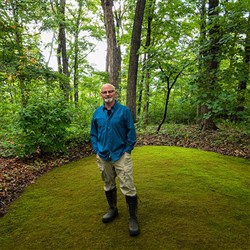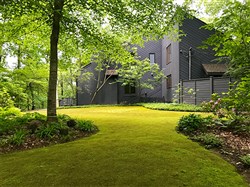VOL. 46 | NO. 44 | Friday, November 4, 2022
No mow grass! Greener options for your lawn
By Catherine Mayhew
We are living in the Middle Ages. Go up and down most any street and you’ll see the evidence all around you. Lawns everywhere.
Life was perilous during medieval times, so the lawn was invented as a way to provide a flat clearing from which landowners could see threatening armies approaching their estates.
By the late 17th century, nobility had adopted the lawn as a way to display their wealth. Not using land for practical reasons, like growing food, was a status symbol.
In those formative decades, the lawn was manicured either by animals grazing on them or by peasants using sickles and scythes. It was a happy day for the lower class when the lawn mower was invented in 1830 by Edwin Budding near Gloucestershire, England.
Lawns leapt The Pond as a young United States grew. President Thomas Jefferson was among the first to replicate a European-style lawn at Monticello in 1806. Other people of wealth followed suit. It was only the average American who still maintained the turf around his house as a vegetable or herb garden, or for grazing animals.
While lawns are still, by far, the most popular way to accessorize a home, there’s a growing movement of people who want to return to a more natural alternative. Crashing insect populations, the predominant use of pesticides and areas prone to drought are highlighting the need to return to a more eco-friendly approach.
“America is unique in its fixation on the monoculture lawn,” Dennis Liu, vice president of education at the E.O. Wilson Biodiversity Foundation in Durham, North Carolina, told the PBS News Hour recently. “Our English inheritance is our own little tidy green space. The more you can make your little piece that you’re a steward of go with nature’s flow, the better off everyone is.”
Will Cafaro, installation project manager for Nashville Foodscapes, puts it more bluntly.

“Moss Boss” Paul Moore says his carefully and patiently grown moss lawn “conjures up a magical forest.”
-- Photographs Provided“The American lawn is one of the worst things we could possibly do and it’s pure insanity from a logic point of view,” he says. “You’re putting in effort to maintain something that shouldn’t even be there.”
The Moss Boss
Lots of plants can take the place of a traditional lawn in Middle Tennessee. Among them are clover, creeping jenny and native grasses.
But for Paul Moore, a Nashville-based plantsman and photographer, it’s all about the moss.
Moss has a lot going for it. It attracts beneficial insects that are a food source for other animals. It helps retain water and is easy to care for once it’s established. No pesticides or fertilizers necessary.
“I’ve got a long history related to plants,” Moore says. “My dad and I owned a garden center for 35 years, and we sold everything from bedding plants to bags of mulch. But about 10 years into the business, I really got involved in the native plant world and, at that time, there wasn’t much of a world.
“Some years later, that interest transferred into my garden at home which is a sanctuary of native plants.”
While most of his yard in the Bellevue area was thriving, he had a hard time maintaining the lawn. Poor conditions led him to he continually replant the grass lawn. Then one day he noticed a small patch of moss that was thriving. The light bulb went off.
“I wondered what this little patch of moss would do,” he recalls. “By the next spring that patch had grown larger, and there was this green hue over the rest of the soil. And I let it grow all that year, and it was looking better month by month, and I thought, ‘this is really going to happen.’

Paul Moore nurtured a small patch of moss into a thriving ground cover for his Nashville home.
-- Photographs Provided“One thing gardeners don’t do very well is just allow a process of any kind to just happen,” Moore adds. “I just simply watched and learned and then I began to read and glean whatever information was out there. After about three years into this new moss area, I said I’m going to tackle this much bigger area and do the rest of my lawn.”
Today, that yard is a lush and verdant green. And Moore now preaches on the virtues of moss to anyone interested in trying it out.
He advises newcomers to moss to start small. “Start a small area,” he says. “Start a little circular area and put a bench there. You learn what the moss requires. Moss does not like competition, so you need to get it down to bare soil. The cool thing about moss is it has no roots. It has rhizoids that are kind of like suction cups.”
He’s recognized as such an authority that the University of Tennessee Institute of Agriculture has published his writings. In fact, he’s known as the Moss Boss, The Moss Wizard or the Moss Evangelist.
“Something that started as an obscure interest has turned into a passion,” he says. “Moss just conjures up a magical forest.”
Less mowing, more growing
Many options exist for replacing a traditional lawn with more environmentally friendly plants, many that already thrive in the wild. The National Wildlife Federation has a native plant finder that will identify which species grow best in your region.
In Middle Tennessee, the federation recommends violets, geraniums, St. John’s wort, evening primrose and goldenrod among the choices.
Another option is ornamental grasses, including fountain grass, maiden grass and muhly grass. Even mulch and rock beds can replace a lawn.
But for those who really want to commit to returning to a time when areas around a house contributed to the daily existence of homeowners, go with plants that produce actual food.
Nashville Foodscapes has been planting edible gardens for the past 12 years. “We do edible for humans – gardens, fruit trees, herbs,” says Cafaro, a project manager. “But we’re also thinking about wildlife, so we plant a lot of pollinator support plants. Food for everybody.”
Cafaro says parts of Tennessee, particularly East Tennessee, are second only to the Amazon in its biodiversity, and there are many crops that will grow here that homeowners might not even know exist – things like Asian pears, ginseng and paw paws.
“We have a year-round growing season, everything from greens to different types of fruit,” he says. “There’s even a hardy citrus that grows here. It’s fun busting out the plant list for clients.”
As with the moss lawn, Cafaro advises people who want an edible garden to start small.
“Everybody can do it if they want to,” he says. “It doesn’t have to be an all-or-nothing thing. Just putting in a few plants is a huge step. You don’t have to go full off the grid to do a little good in your yard.”
And back to that conventional grass approach, Kim Brown, a turf grass specialist with the University of Tennessee Extension Service in Jackson, says there’s a healthy compromise between a traditional lawn and a more biodiverse yard.
One alternative is a refuge lawn, a project between the United States Department of Agriculture and the National Institute of Food and Agriculture that is searching for ways to improve pollinator heath.
“It connects people, plants and pollinators,” Brown says. “We still want to have the lawn, but maybe we do a reduced mowing or reduced pesticides and just let the native plants come in. You’re just looking at flowering sequences for low-maintenance areas, but you still have some of that lawn area.”
Brown’s other suggestion is to just plant a more suitable grass that doesn’t require as much maintenance.
“We’ve really improved our grass varieties through breeding and selection,” she says. “Why don’t we just select grasses that require less inputs? They don’t require the amount of fertilizers or mowing.”
The Jackson extension station has a turf circle with different types of grass that demonstrate varieties that thrive in the area. “I manage it as a homeowner would,” she says. “We’re trying to demonstrate improved varieties.”
Elemental Green is a California-based design company that helps homeowners choose sustainable building materials, finishes and gardens. It’s used all the techniques – wildlife habitats, garden beds, low maintenance ground covers and urban farms – to transform traditional lawn yards.
“For our last garden renovation, we took out some of the turf areas and replaced them with raised vegetable gardens and fruit trees. Other areas were overseeded with micro-clover to lower water usage and enhance the soil without the need for fertilizer,” says Sheridan Foster, the company’s CEO.
“You can pick the look you want – a lovely flowering garden, xeriscape, a green carpet or beautiful and productive fruit trees, shrubs and vegetable beds. And all come with the peace of mind that blossoms when making a positive impact on the planet.”